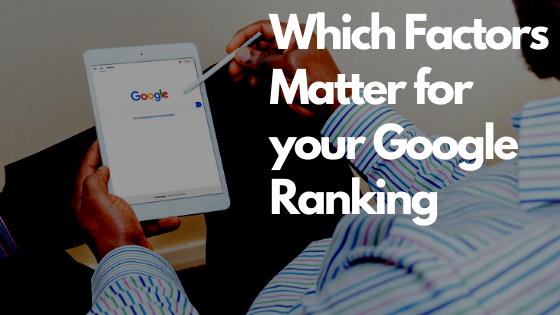At the start of the year, there were 1.94 billion live websites on the World Wide Web and Google is used more than 3.5 billion times every single day, by people looking to find what they want.
Google aims to show the most relevant and accurate results to a users search. To do this, Google has to learn and understand pages and then match that to users search and intent.
Knowing the factors that Google use to rank your website can help you ensure your content has the best possibility of appearing as a search result, nearest to the top. Google uses over 200 factors in its organic search rankings – but there is no published list of these.
If you have good relevant content and a secure, fast site its a great start. There are lots of technical things in the background to make sure Google can read and try to understand your website too. Looking at all these factors is called Search Engine Optimisation (SEO).

Content
If you want your website to appear near the top on Google, the most important thing you can do for search engine optimisation is to create high quality and unique content that is well-structured and easy to read.
We recommend that if the content on your site needs work, improving it, rather than deleting it, is the best way to improve your ranking.
Relevance
Simply putting the keywords into your pages doesn’t work (it may have done five years ago). Content needs to not only match certain words but be relevant and useful for the intended audience. That means looking into the search terms they use to see what they’re asking and giving them the answers within your content. Making sure your content is what your clients are looking for and demonstrates your knowledge/niche/product that suits the topic.
Eight years ago, one of our founders created a site for buying cars from consumers. Initially, this was built on the idea that people would search using the “sell my car” phrases. Using analytics, we found that people were using “buy my car” more so we moved the focus to increase traffic. It’s therefore essential to look at your keywords from different perspectives.
Content Structure
Build relevant keywords into your page titles, H1 and H2 tags. Write meta descriptions that are very specific about the page and include structural text and media elements like images, videos or bulleted lists to deliver the answers or information your clients are searching.
Website Structure
Your website should be set out clearly, with page URLs that include keywords to give Google simple information about the page and where it belongs on your website. Think of your website like a building – all exits and rooms should be clearly marked, and there should be signs to get the visitors where they want to be.
Security
Any website now should use a secure connection (SSL or HTTPS) to protect the personal and financial details of your website’s visitors. As of July 2018, Google Chrome has displayed a ‘Not Secure’ warning for any site that doesn’t use this, so if you aren’t using an SSL certificate on your website, you really should. We can help with that – contact us for advice. Not only will your Search Ranking improve, but you’ll also be less vulnerable to hackers trying to intercept sensitive data.
Mobile Friendliness
Nearly 80% of your customers will now use their mobiles to visit your site. This means that making sure your website is responsive for use on mobile devices is very important. Google is now using mobile-first indexing – this means it uses the website’s mobile version for indexing and ranking instead of the desktop version.
Links
Another good factor is having quality links to your website. This is content on other sites that refer and link to your page. This can add credibility and generate traffic. It shows that that others trust your site enough to link to your page. Try to get links from trade associations, blogs, supplier and other customers. Never pay anyone for links – these end up negatively affecting your site as Google will discover the links originate on very spam-like sites.
You should also have links between different pages on your website. Internal links within your own site help Google understand how your website is structured, how the content on your site is related, and which pages on your site are the most important. The duration a user spends on your website is made longer by having the related content and internal links. Google uses this information to rank sites users spend time on.
Page Speed
Google uses page speed as a ranking factor. Primarily how quickly the page loads. Research shows people expect a website to load within a few seconds. If any longer, they will most likely move onto the next search result.
You should check your website performance regularly and keep your site fast with page speed optimisation methods such as image compression and making sure you have a good website hosting provider. Check your speed by visit our Website Speed Blog here.
We can help!
We do all of the above and more for our clients during and after the design of their website. Getting to the top of Google is no easy task, but it can be done. We have lots of case studies and examples of successes that we then build into every site we build.
